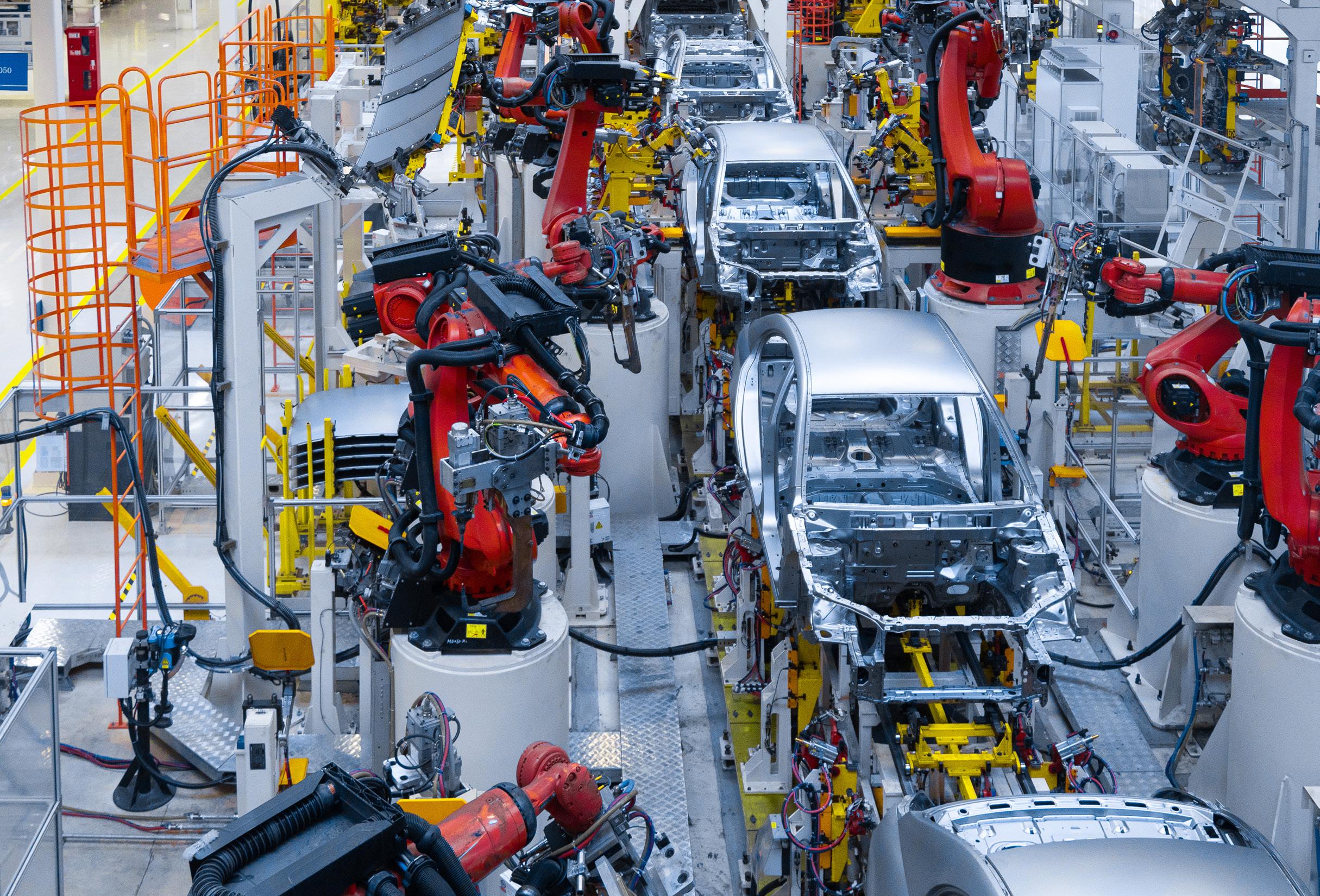
11 minute read
Feature: Future of work
What does the rise of the robots mean for UK jobs?
Robots were long the realm of science fiction writers – but with Industrial Revolution 4.0 delivering incredible advancements in technology and artificial intelligence, robots are making the leap from fantasy to reality. What does this mean for human employment? Business Leader investigates.
“The problem for the UK labour market
and our economy is not that we have too many robots in the workplace, but that we have too few,” says a new government study analysing industrial automation. “The risk we face is not a robot takeover of our workplaces, but that our lack of adoption and the reluctance of businesses and the government to lead the way in the Fourth Industrial Revolution means other countries will seize the initiative and take the advantage of new technologies – not least the growth and jobs they bring – while we are left behind. “If we fall further behind in productivity and the adoption of new technologies, then future investment decisions will not follow. Businesses, investment and jobs will move overseas.”
This stark warning comes from the crossparty Business, Energy and Industrial Strategy (BEIS) Committee’s new report 'Automation And The Future Of Work', which makes it clear British industry needs to rise to the challenge of automation – and do it quickly.
But which sectors are embracing robot technology? And what are the implications for the nation’s human workforce? Why do we need robots? From robot waiters to driverless cars, robot tech is infiltrating day-to-day life at an unprecedented rate. Companies embracing automation are doing so for a variety of reasons: tasks can be too complex for humans; too mundane and repetitive for people to want them; risks could make jobs too dangerous; robotic output may far outstrip a human’s; or employers may wish to trim their wage bill. UK firm Bots.co.uk, a leading authority on robots as a service, believes safety is often the driver. However, it says many industries have seen major growth in robot application, ranging from nuclear site cleaning to cow herding, and from oil pipeline inspections to firefighting. A Bots.co.uk spokesperson said: “Robots as workers are really taking off to fill dangerous jobs people can’t find employees for. As the market develops, we see more dangerous jobs – from emergency rescue to protecting environmental sites – as being ideally suited to robots. “(But) it isn't just safety where bots are excelling, because in many ways they also offer a new level of accuracy and efficiency in completing tricky tasks.” Indeed, efficiency and intricacy are big motivators for transferring tasks from human hands to metal ones.
“Smart robotics and automation are vital to deal with new consumer trends, demand for product variety or challenges from trade barriers,” says Dr Susanne Bieller, General Secretary of the International Federation of Robotics. “New technological solutions pave the way for more flexibility in production.” Real-world innovation Bristol Robotics Laboratory (BRL) at the University of the West of England is home to many of the nation’s robotics pioneers. not only reduce false diagnoses, but also mean cancer can be spotted earlier, when it is harder to detect – but potentially more treatable.
And while a human bedside manner is one of the most valued elements of medical care, BRL has made real progress in this area too.
Scientists have created the world's first socially intelligent humanoid fitness coach, which offers motivational voice prompts and gestures to guide people through personalised exercise regimes. It tells jokes, shows sympathy, uses human-style body language and even changes its eye colour to express different emotions. Even creative industries, where a human touch has long been rated vital, is seeing artificial intelligence (AI) emerge as a force. In December, the BBC used computers to write its general election news coverage. Machine-generated stories – in both English and Welsh – were published for every constituency, albeit they were checked by a human editor prior to going live. Respected publications such as the New York Times and Reuters use articles created by AI too, while the Press Association produces up to 30,000 stories a month in this way.
AI writers are not restricted to formulaic or data-driven works, either – they are now producing poetry and novels too. What roles are at risk? While it’s clear some roles will be rendered obsolete, it’s not as clear-cut as pointing at specific industries or roles, as there are plenty of other factors in play. Age, gender, location and education are all important, according to the Office for National Statistics (ONS). Jobs rated a high risk of being lost to automation are held by women in 70% of cases – which compares unfavourably with the 42% of females in roles considered low risk. "IF WE FALL FURTHER BEHIND IN PRODUCTIVITY AND THE ADOPTION OF NEW TECHNOLOGIES, THEN FUTURE INVESTMENT DECISIONS WILL NOT FOLLOW. BUSINESSES, INVESTMENT AND JOBS WILL MOVE OVERSEAS." Its experts are working with North Bristol NHS Trust (NBT) to roll out robots in hospitals; as a result, Southmead Hospital is now one of the most technologically advanced in Europe, with robots conducting cancer operations, dispensing medicines and analysing blood samples. Robotic surgeries are rated as ‘more accurate and less invasive’ than procedures by humans and reduce both blood loss and the length of hospital stays, while automated vehicles transport food, linen and medicine around the hospital 24/7. Professor Praminda CalebSolly, leading research in Assistive Robotics and Intelligent Health Technologies at BRL, said: “Robotics can enable a more effective use of the workforce, allowing humans to give the human contact and robots to be used as smart tools to support and complement their work.” And NBT Clinical Director Tim Whittlestone added: “Robots can help us do some of the more mundane, repeatable tasks and free up staff to do what they do best – listening, thinking and caring.” Google Health made headlines recently after unveiling tech which can identify breast cancer more accurately than radiologists. Dr Susan Bieller
Simon Howes


Mike Wilson
into their business – which he believes is limiting their success. He said: “Although the UK ranks as the eighth largest industrial nation, we are 22nd in the global league of robot adoption – we must ask why that is. “Finding technological solutions is increasingly important. There is an opportunity to do more with robots: you can see this in the continuing drive to increase productivity, and the need to find new ways to operate with fewer staff.” This need to cope with smaller teams is another key reason to accelerate tech adoption, according to Mike Wilson, Chairman of the British Automation and Robot Association. He warns: “The United Kingdom has been adding robot automation at a lower rate than our main competitors in all manufacturing sectors outside of automotive. “Over many years, the UK has attracted workers from other countries, with businesses preferring to hire people rather than invest in capital equipment. The consequences of the Brexit vote and subsequent political developments are leading to reduced labour availability as many workers who have come over from Eastern Europe are starting to return home. “As a result, businesses have to ensure they use their workforce effectively and find Part-time roles are substantially more at risk than full-time jobs, while people aged 20-24 are most likely to be usurped by robot labour. Location is a significant barometer too. Roles in London and the South East are mostly rated low risk, but there are highconcentration pockets of ‘at risk’ roles in other regions, especially poor, former industrial areas. However, education emerges as arguably the most important differential. People with a degree look to be safest by some margin, accounting for 87% of the ‘low risk’ category – and none of the ‘high risk’ section. Altogether, the ONS says 7.4% of the 19.9 million jobs in England are in sectors at high risk of automation – a total of 1.5 million jobs. How is the UK performing? It’s fair to say the UK has significant work to do to become a genuine force in robotics – yet doing so could have an immediate and much-needed impact. The country has been in the grip of a productivity crisis for more than ten years, with manufacturing recently recording its worst quarterly performance in a decade. Simon Howes, Managing Director of the South West Manufacturing Advisory Service, says just 18% of manufacturing firms in the region have introduced robots "ALTHOUGH THE UK RANKS AS THE EIGHTH LARGEST INDUSTRIAL NATION, WE ARE 22ND IN THE GLOBAL LEAGUE OF ROBOT ADOPTION – WE MUST ASK WHY THAT IS."
Simon Howes
58 alternative ways of performing tasks for which they have a shortage of staff – robot automation being an obvious solution.”
What comes next? “The onset of new technological advances – artificial intelligence, automation and robotics – are already creating vast opportunities for new jobs,” according to the United Nations General Assembly.
“Yet, those who lose their jobs as result of new technologies may be less equipped to seize new opportunities and may be added to the ranks of the long-term unemployed.
“Global dependence on technology means skills in demand today will not match the jobs of tomorrow. Skills acquisition and lifelong learning will be required for workers to remain agile and employable.”
And that is crucial, it seems. Ensuring human workers are supported rather than displaced – and advances improve quality of life for human workers, rather than leaving them redundant – must be the focus.
That will require strong leadership from both public and private sectors, according to BEIS.
It concludes: “Rather than massunemployment or the end of work, we are convinced well-managed automation is likely to improve the quality of work, create new jobs and boost UK productivity.
“Historically, large industrial transitions have seen changes to work but, rather than causing long-term job losses, they have resulted in more of the population in work than before and the quality of work improving.
“If managed well, the transition to a more automated British workplace should make businesses more productive, improve the supply of high-quality jobs and support working people to have more leisure time.
“It this transition is managed badly, entire groups and regions could be left behind, British businesses could find themselves uncompetitive and SMEs will continue to form a long trail of unproductive businesses.
“The government needs to take more seriously the opportunities and risks of automation. It should collaborate with all those who want to harness automation to boost productivity and living standards – and it should not delay in doing so.”
5 TIPS FOR FAST GROWTH

1. Have a clear vision and share it Too often, Founders and CEOs of businesses will think about the people that they need for the next stage of growth before they have clarified their vision and where they’re trying to go. It won’t be the first time that somebody has set off for Bali and arrived in Amsterdam. It is absolutely imperative that your vision is fine-tuned, your ambitions clear, and your goals set before you start moving people around or recruiting new people.
2. Evaluate you team for skill gaps When you’re clear about your strategy, vision and goals, take the time to evaluate your current team in order to truly understand what you have and what you need. Different journeys call for different skills, behaviours and even people. We suggest that before you set off, you take a thorough look in the kit bag.
3. Structure your business for the future, not for today Once the destination is clear and you understand what you have in your team, look to build a structure that is fit for two or three steps ahead of where you are now. Growth often comes quickly and it is critical that your structure is capable of supporting the business through the peaks and troughs of accelerated growth.
4. Recruit with the future in mind Just as you should build a structure that is fit for growth, you should also recruit ahead of your growth curve. By doing this, you will ensure you have people that are capable, not only of achieving next year’s financial goals but the full three-year plan. This may seem expensive at the time but experience is invaluable and costs soon turn into profits if your new team hit your plan ahead of time.
Get in touch with our CEO Orlando Martins to hear how we can help your business grow. Tel: +44 (0)20 3675 1459 Email: orlando@oresa.co.uk
5. Find the people who fit When recruiting, build on your culture and find people that absolutely fit. Too often, companies rush to recruit because they have a vacancy and sacrifice either the cultural or technical fit. Rarely does this work and it is the key reason why a significant number of recruits fail. We have developed a system that guarantees fit and we advise our clients to focus on this to ensure that they recruit people who propel their growth, not hold them back.
About ORESA ORESA transforms businesses from the top down. For over a decade we’ve put leading executive talent into digital, retail, fashion and consumer organisations that have delivered exceptional growth. But we’re more than executive search – we’re growth strategists. We propel companies to growth by bringing together strategy, leadership advisory and executive search.










